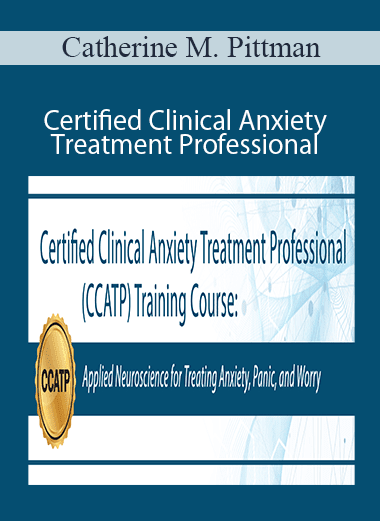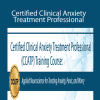Catherine M. Pittman – Certified Clinical Anxiety Treatment Professional Training Course
$199.00 Original price was: $199.00.$59.00Current price is: $59.00.
Instant Download: You will receive a download link via your order email immediately
Should you have any questions, please contact us: [email protected]
 Catherine M. Pittman – Certified Clinical Anxiety Treatment Professional Training Course
Catherine M. Pittman – Certified Clinical Anxiety Treatment Professional Training Course
Advances in neuroscience have provided a roadmap for the brain that shows us the key to working with anxious minds. But knowing how to interpret the complex map neuroscience provides has left many clinicians wondering… How do I unlock the complicated inner workings of the brain to guide my client sessions?
In this comprehensive training, you’ll see how neuroscience can inform why, how and what techniques can help your clients stop the symptoms of anxiety — even the tough to treat panic attacks, worry, rumination, nausea, and pounding hearts.
Now you can join Catherine Pittman, Ph.D., HSPP, for a comprehensive step by step clinical training on how you can revolutionize your anxiety treatment approach with the power of neuroplasticity.
More than just the neurobiological “whats and whys,” you’ll also learn the “hows” of actual treatment — so you’ll know exactly how to empower your clients with strategies to resist anxiety-igniting cognitions.
You’ll end this course fully prepared to integrate brain-based strategies that motivate lasting change for calming the mind — even in your most anxious, worried, traumatized, or obsessive clients.
Bonus! Now you can become a Certified Clinical Anxiety Treatment Professional. Complete this online course to easily advance your career. Learn more below…
Today’s advances in neuroscience have provided us with more evidence-based explanations about the causes and treatment of anxiety-based disorders than any other clinical disorder you’ll see in your practice.
Through 10 comprehensive modules, you’ll learn through easy-to-understand language how you can apply neuroscience to your anxiety treatment plans to effectively and easily modify the processes in the brain that give rise to anxiety — so you can help your clients find deep, lasting relief from panic, worry, trauma, and obsessions.
- How you can help your anxious clients understand their own symptoms, feelings, interpretations, beliefs
- What to do when treatment strategies for anxiety produce anxiety
- How to work within the goal of changing the brain rather than the goal of reducing anxiety
- How neuroplasticity makes the brain more resistant to anxiety
- Simple explanations you can share clients about how anxiety travels through their brain
- Why amygdala management is essential for all Anxiety Disorders, PTSD, OCD, Depression
- The amygdala’s role in the stress/fear/anxiety response and formation of emotional memories
- How to train the brain to stop responding to negative anxiety “triggers”
- The Vagus nerve’s role in recovery from the activation of the sympathetic nervous system
- Interventions that reduce anxiety “fuel” produced in the amygdala
- Using exposure: safely activating the fear circuitry created in the amygdala to generate new connections
- How the cortex constructs reality
- How to resist the effects of anticipation and the healthy (adaptive) use of worry
- “Survival of the busiest” principle — strengthen or weaken specific circuitry
- How to recognize and modify the impact of uncertainty
- Left hemisphere techniques: How to use cognitive defusion, coping thoughts, and fighting anticipation
- Right hemisphere techniques: How to use imagery and music
- The myth of the chemical imbalance
- Tools for assessing medication use during the initial intake
- How SSRIs and SNRIs promote neuroplasticity
- The danger of sedating the brain with benzodiazepines
- And overview of buspirone, beta blockers and sedatives/hypnotics/z-drugs
- The effectiveness of CBT and meds
- Tools for helping clients learn to reduce avoidance and push through anxiety
- How to prepare clients for exposure: psychoeducation, breathing training, cognitive restructuring
- In vivo vs. imaginal exposure approaches
- Interoceptive triggers and methods for exposure
- Use of Subjective Units of Distress/Discomfort Scale (SUDS)
- Concerns associated with safety signals, medications, distraction
- How to troubleshoot problems
- Defining basic emotional reactions: Attachment, Aversion, Indifference
- How to practice self-acceptance and erase the detrimental effect of judgment
- Using mindfulness to explore thoughts, sensations, and emotional reactions
- How to use the power of intention to focus thoughts in new directions
- Tools for coping with common reactions to aversion
- Using CBT and neurological knowledge to strengthen client engagement
- Advantages of the strategic use of neuroscience in CBT
- Why focusing on logic and disputing has limits
- Using skills-based approaches in CBT to provide the brain experiences to learn
- How the hippocampus impacts negative thinking
- Exercises to help clients focus on the positive
- Addressing worry, rumination, and common cognitive errors in depression
- Benefits of goal setting and behavioral activation
- Key role of social support and social interaction
- How to challenge distorted thoughts and unrealistic beliefs and images
- How to identify and stop anxiety-igniting thoughts common in OCD and GAD
- Strategies for helping clients embrace uncertainty
- Making OCD or worry the adversary: Don’t be bullied!
- Why clients should schedule obsessions or worries to bring them under control
- Explaining implicit emotional learning and identifying examples
- How to assist the client to experience the memory structure in the present moment
- How to promote your client’s experiential learning of emotional truth
- Steps for disconfirming the emotional memory with “mismatching” information that invalidates it
Proof Content
 Sale Page: https://catalog.pesi.com/sales/bh_c_001269evg_ccatp_012320_organic-105517
Sale Page: https://catalog.pesi.com/sales/bh_c_001269evg_ccatp_012320_organic-105517
Archive: https://archive.ph/wip/idgh6
Delivery Method
– After your purchase, you’ll see a View your orders link which goes to the Downloads page. Here, you can download all the files associated with your order.
– Downloads are available once your payment is confirmed, we’ll also send you a download notification email separate from any transaction notification emails you receive from imcourse.biz.
– Since it is a digital copy, our suggestion is to download and save it to your hard drive. In case the link is broken for any reason, please contact us and we will resend the new download link.
– If you cannot find the download link, please don’t worry about that. We will update and notify you as soon as possible at 8:00 AM – 8:00 PM (UTC+8).
Thank You For Shopping With Us!
Be the first to review “Catherine M. Pittman – Certified Clinical Anxiety Treatment Professional Training Course” Cancel reply
Related Products
Medical & Health
Medical & Health




![[Download Now] Rewire the Anxious Brain: Using Neuroscience to End Anxiety](https://imcourse.biz/wp-content/uploads/2022/02/Using-Neuroscience-to-End-Anxiety-Panic-and-Worry-by-Catherine-M-400x556-1.jpg)


9 reviews for Catherine M. Pittman – Certified Clinical Anxiety Treatment Professional Training Course
There are no reviews yet.